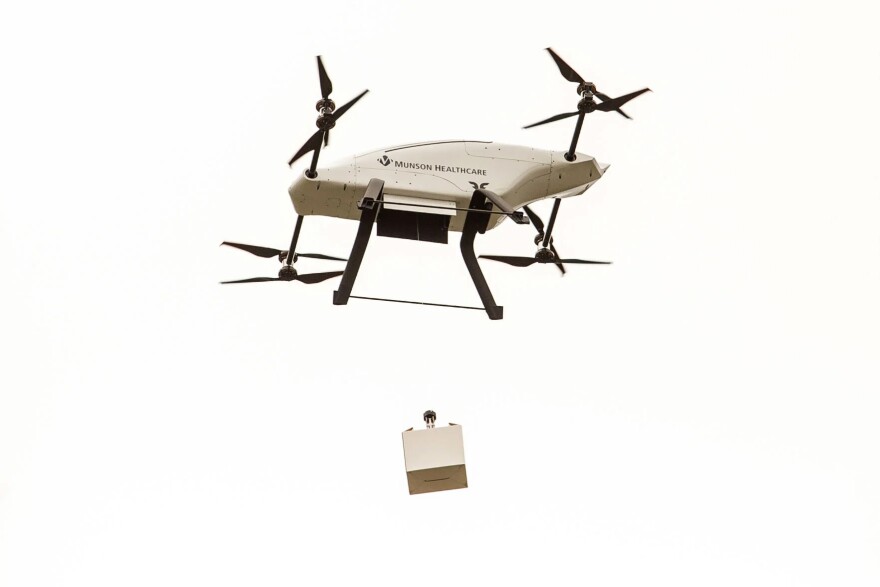Munson Healthcare and Traverse Connect will soon begin testing phase two of a drone delivery program that could deliver medical supplies, samples and medications across northern Michigan.
Funded by a $689,500 grant from the Advanced Aerial Mobility Activation Fund, the initial phase included drone flights between Munson Medical Center, Copper Ridge Surgery Center and the Munson Dialysis Center from May 5-22.
The goal was to evaluate safe, line-of-sight flights before seeking Federal Aviation Administration approval for beyond-visual-line-of-sight operations, which would enable broader use of drones across the 23-county region Munson serves.
Staying within the visual line of sight entailed observers on the ground, maintaining contact with the drone between its origin and destination for each flight.
Tracy Cleveland, vice president of Munson Supply Chain, was one of the primary founders of the program.
“Phase one was a resounding success,” Cleveland said. ”In approximately two weeks, we did over 100 flights between locations within a mile of the medical center.”
Katherine DeGood, director of marketing and communications with Traverse Connect, felt similarly.
“I don’t think it even went exactly to plan, it went better than the plan for everybody,” she said.
Frank Noppel with Blueflite, the company that manufactured two drones for the program, said success in such tests is measured by specific metrics and key performance indicators.
Noppel said the drone delivery program is following a phased approach known as the “crawl-walk-run” method. It begins with simple, short-distance flights between a limited number of medical sites to help operators understand how drones interact with medical logistics.
Each flight provides insights into operations, weather, airspace and the handling of medical goods.
The program slowly moves into more complex phases involving longer distances, more locations and streamlined operations with fewer personnel.
“It’s iterative,” Noppel said. “Every time you learn, you make certain adjustments until you feel confident enough to go into the next phase.”
Cleveland said phase two of the program, which is expected to begin in August or September of this year, will build on lessons learned from phase one and possibly include more high‑volume Munson clinics and collection sites.
He said the second phase will stay focused on transporting laboratory samples, evaluating the impact of drone versus human deliveries.
“I think it’s important for people to understand how controlled (this testing) is,” Cleveland said. “It’s very safe. We’re really taking it step by step to ensure not only the quality of the samples that we’re transporting, but the safety of everyone involved.”
The program also reduces the need for staff to drive vans, allowing them to shift focus back to patient care within the hospitals, according to DeGood.
Phase two will be going beyond the visible line of sight, which means the drone pilots will rely on technology such as GPS to fly the craft.
Noppel said going beyond the line of sight is primarily a regulatory hurdle, as the airspace and location of flight will stay the same.
After phase two is completed, Cleveland said there is still more to come. A third phase of the program will take flight, further developing the capabilities of drones in northern Michigan.
The Michigan Advanced Air Mobility Initiative was recently announced by Gov. Gretchen Whitmer, which will award nearly $1 million to Traverse Connect to continue the program.
DeGood said phase three will entail more flights to more locations, assessing “long-term feasibility and scalability.”
Warren Call, president and CEO of Traverse Connect, said in a release the organization is “honored” to receive the additional funds.
“Northern Michigan’s emerging aerial mobility hub of public, private, and nonprofit partners is driving innovation and economic opportunity, while developing solutions for local and statewide challenges,” the statement reads.
Noppel said ultimately the goal of the program is to improve patient care by speeding up the delivery of critical medical items like lab samples, especially in rural regions like northern Michigan, where transportation delays can slow diagnoses and treatment.
Drones offer a faster, more cost-effective alternative to road transport, reducing wait times and operational expenses, he said.
“Obviously, there is a coolness factor around utilizing drones,” Noppel said. “(But there’s) a very serious business case behind it that helps reduce cost on the medical and the clinical side and at the same time improves patient outcomes and patient care.”
This story was produced in partnership with the Traverse City Record-Eagle as part of the Michigan News Group Internship Program, a collaboration between WCMU Public Media and local newspapers in central and northern Michigan. The program’s mission is to train the next generation of journalists and combat the rise of rural news deserts.



